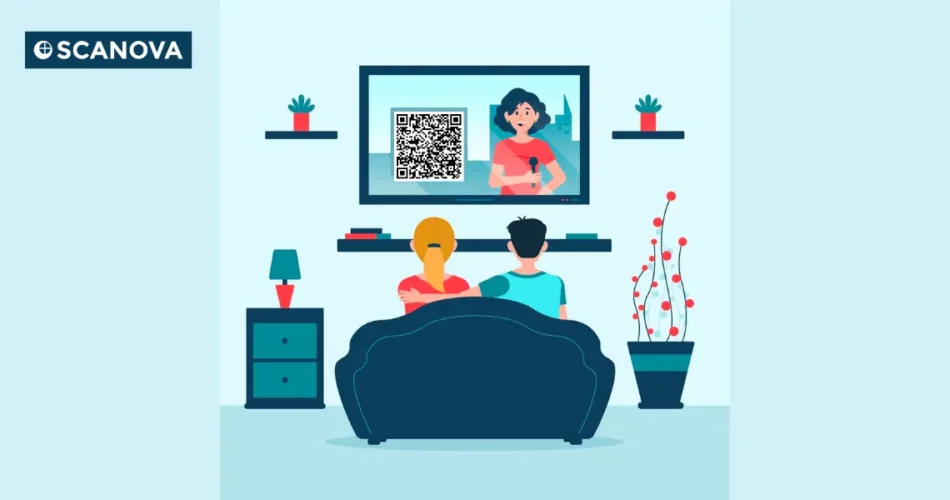In a nutshell: QR Codes on TV commercials turn passive ads into interactive experiences. Viewers can scan instantly to get offers, make purchases, or watch extra content. Brands gain measurable results, real-time engagement, and a bridge between TV and online content. With clear placement, mobile-friendly pages, and strong CTAs, QR Codes make TV ads smarter, trackable, and future-ready.
In the age of smartphones, television commercials are no longer a one-way street.
Advertisers increasingly use QR Codes on TV commercials to bridge the gap between the TV screen and the interactive world in your pocket.
But how exactly are these codes working their way into your living room, and what benefits do they offer? Let’s find out!
Did you know? According to projections, television advertising income will total $81 billion by the end of 2025. These findings suggest that television advertising should not be eliminated but paired with an interactive marketing tool like a QR Code.
A. Why QR Codes on TV ads?
TV advertising is powerful for reach, but traditional commercials struggle to drive measurable engagement. Today’s viewers watch with a phone in hand, which makes QR Codes the perfect bridge between broadcast and mobile action.
Recent data highlights this shift:
- 75% of consumers prefer interactive TV ads over passive commercials, and 55% regularly use their smartphones while watching TV (Source: Bitly).
- A U.S. survey found up to 60% of 18–34-year-olds have scanned a QR Code on TV, and 48% of all viewers say they would scan one to learn more (Source: PR Newswire).
These numbers show why QR Codes in TV commercials are no longer a novelty. They turn passive viewing into interactive, trackable advertising.
B. Evolution of TV advertising: Why QR Codes matter now?

TV advertising has always been about reach, but today’s audiences engage differently than they did a decade ago. With streaming, on-demand content, and the growth of connected TV (CTV), viewers are no longer passive.
More than 55% of people use their smartphones while watching TV, which shows that the “second screen” is part of everyday viewing.
This shift creates both a challenge and an opportunity for advertisers. Traditional commercials build awareness but rarely drive immediate action. Viewers see the ad, then return to their program without engaging.
By adding QR Codes in TV ads, brands can connect directly with that second screen. A quick scan lets audiences shop products, join promotions, or download apps in real time.
In short, interactive TV ads powered by QR Codes make campaigns measurable and actionable. Whether on broadcast, OTT, or CTV platforms, QR Codes turn static commercials into trackable, shoppable TV ads that link attention on the big screen to action on mobile.
C. Advantages of using QR Codes in TV commercials
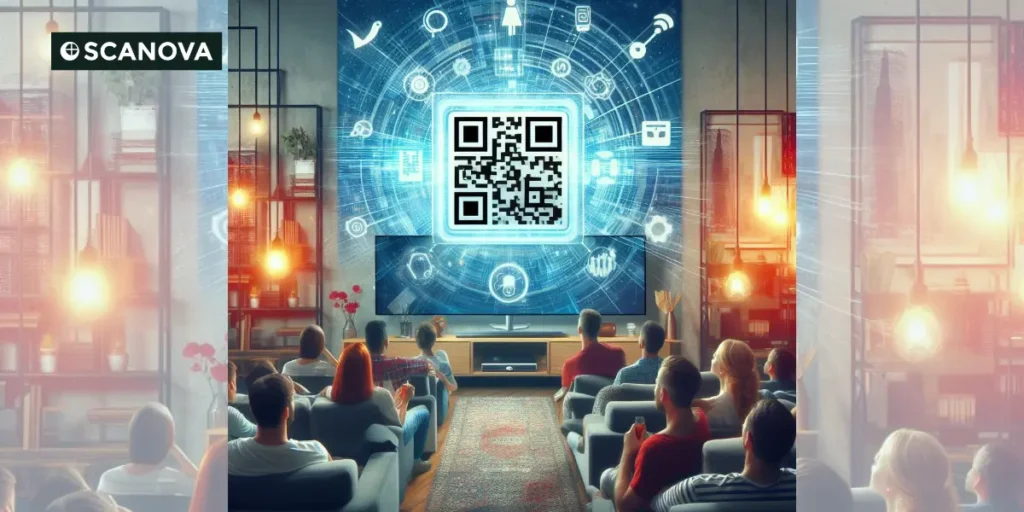
QR Codes offer several advantages for advertisers looking to enhance their TV commercials:
1. Instant Access to Additional Information: Imagine seeing a product advertised on TV and wanting to know more – its features, price point, or availability.
QR Codes eliminate the hassle of remembering website addresses or searching online later. A quick scan and viewers are on a dedicated landing page with all the details they crave.
2. Facilitating Interactive Engagement: QR Codes on TV commercials go beyond simply providing information. They can be used to create a more interactive experience for viewers.
For example, a code could lead to a behind-the-scenes video, a fun quiz related to the product, or even access to an exclusive discount code.
This active participation can make viewers feel more involved with the brand and leave a lasting impression.
Did you know? According to studies conducted by Nielsen in 2022, including QR Codes in TV episodes increases brand memory by 30% among viewers.
3. Tracking and Analyzing Consumer Behavior: One of the biggest challenges with traditional TV advertising is measuring its effectiveness.
QR Codes provide valuable data by tracking how many viewers scan the code and what actions they take upon reaching the landing page.
This allows advertisers to understand viewer interest, gauge campaign success, and refine future strategies for better results.
D. Real-life examples of QR Codes on TV commercials
1. Pepsi’s “Dig In” Campaign
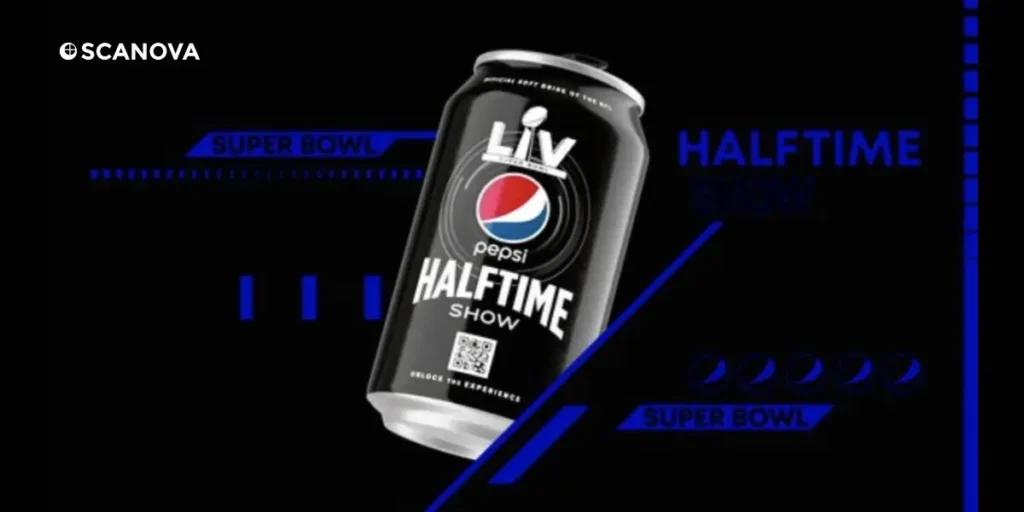
Pepsi’s “Dig In” campaign aimed to promote its new line of snacks by offering consumers an immersive experience that combined the joy of snacking with the excitement of digital content.
The campaign focused on enjoying PepsiCo snacks and accessing exclusive digital content using QR Codes.
2. Toyota’s “QR Code Test Drive” Initiative
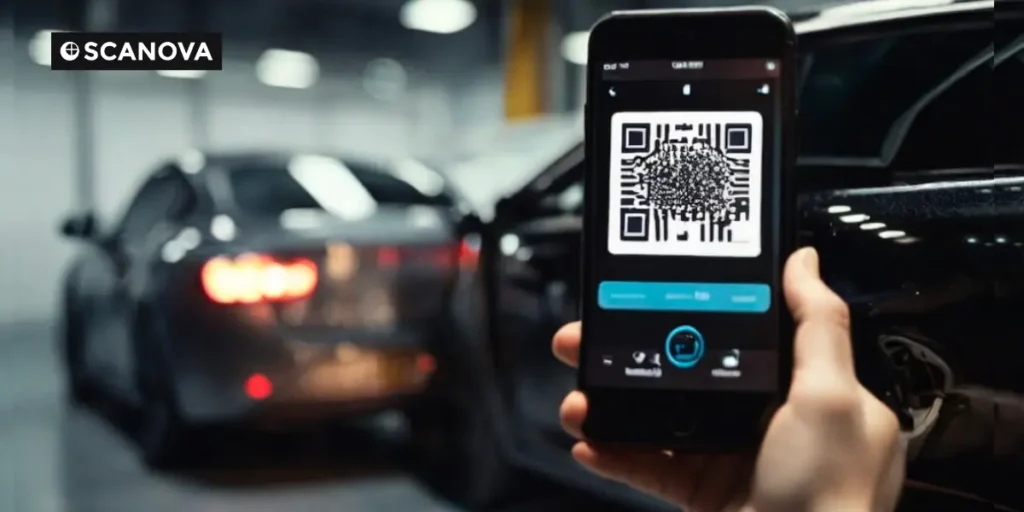
Toyota’s “QR Code Test Drive” initiative aimed to revolutionize the car-buying experience by allowing consumers to schedule test drives directly from their television screens.
The campaign sought to eliminate barriers to test driving, such as scheduling conflicts and dealership visits, by leveraging the convenience of QR Codes and mobile technology.
3. Planters Super Bowl Ad
In 2023, Planters made headlines during the Super Bowl by placing a giant QR Code in its TV ad. Recognizing that viewers watch with smartphones in hand, the brand invited scans to unlock exclusive content and offers.
The result? A 70%+ conversion rate (PR Newswire), proving QR Codes can turn mass-audience ads into interactive, trackable campaigns. With the right call to action and timing, QR Codes don’t just boost engagement, they drive measurable ROI.
E. Best practices for QR Codes on TV commercials

1. Placement and visibility
Strategic Placement: QR Codes on TV Commercials should be placed strategically within the ads to ensure maximum visibility and accessibility to viewers.
They should be displayed clearly and in a manner that aligns with the flow of the commercial. This makes it easy for viewers to notice and engage with them.
Duration on Screen: QR Codes on TV Commercials should remain on screen for a sufficient time to allow viewers to scan them comfortably.
Marketers should avoid fleeting appearances or placing them in areas where they may be overlooked.
Consider factors such as screen clutter and pacing to determine the optimal duration for QR Code visibility.
2. Design and user experience
Clear and Sharp Design: Ensure that QR Codes on TV Commercials are designed to be clear, sharp, and easily recognizable.
Use high-contrast colors and avoid complex backgrounds that may interfere with scanning.
Also, maintain a sufficient error correction level to enhance scanning reliability, especially in places where it may be challenging to view the ad altogether.
Mobile Optimization: Optimize the landing pages or digital content linked to QR Codes for mobile devices.
Ensure the user experience is seamless and intuitive, with responsive design elements that adapt to various screen sizes and orientations.
Prioritize simplicity and clarity to facilitate smooth navigation and engagement.
3. Relevance and value proposition
Provide Incentive: Offer viewers a compelling reason to scan the QR Codes on TV Commercials by providing exclusive content, special offers, or incentives.
Communicate the value proposition of scanning the code within the context of the TV commercial, emphasizing the benefits or rewards that await them.
Align with Brand Message: Ensure that the content accessed through the QR Code on TV commercials aligns with the brand message and objectives of the ads.
Maintain consistency in tone, imagery, and branding elements to reinforce the overall brand identity and enhance the viewer’s perception of the brand.
QR Code-enabled TV commercials saw a 20% increase in conversion rates over traditional ads, demonstrating their effectiveness in driving customer action (Business Insider 2023).
4. Tracking and analysis
Implement Tracking Mechanisms: Incorporate tracking mechanisms to monitor QR Code scans and user interactions in real-time.
Utilize analytics tools to gather data on scan frequency, location, time of engagement, and device types.
This data will allow informed decisions and optimization strategies, providing excellent insight into consumer behavior and campaign performance.
Iterative Improvement: Continuously analyze the collected data to identify trends, patterns, and areas for improvement.
Use A/B testing and experimentation to refine QR Code placement, content offerings, and user experience based on audience feedback and performance metrics.
Build the campaign strategy and refine it again to enhance effectiveness and maximize ROI over time.
5. Use dynamic QR Codes
Dynamic QR Codes let you update the landing page even after the ad goes live. This flexibility ensures that if your offer changes, you do not need to reprint or re-air the ad. You can also track scans in real time to measure performance.
6. Always include a clear call to action
Do not just display a QR Code on-screen. Add short text like “Scan to shop now” or “Scan for the full video.” This tells viewers what to expect and increases scan rates.
7. Make the code easy to scan
Display the QR Code large enough and keep it visible for at least 10 seconds. Avoid placing it in corners with busy backgrounds. A clean frame around the code helps viewers scan quickly.
8. Customize for branding
Add your logo and brand colors to the QR Code so it looks professional and trustworthy. Branded QR Codes are more likely to be scanned because they feel secure and connected to the ad campaign.
9. Test across screens
Always test the QR Code commercials on different TVs and streaming platforms. Make sure the code scans well in HD, 4K, and even on smaller screens.
Key Takeaways
- Place QR Codes prominently and keep them visible for at least 10 seconds
- Use clear, high-contrast designs and optimize linked pages for mobile
- Add a short call-to-action to drive scans and offer real value (discounts, content, rewards)
- Use dynamic QR Codes for flexibility and tracking insights
- Customize with branding and test across screens to ensure smooth scanning
F. Challenges and considerations

1. Consumer adoption and familiarity with QR Codes
One of the primary challenges is ensuring that consumers are familiar with QR Codes and understand how to use them.
Brands may need to invest in educational campaigns to increase awareness and promote the benefits of scanning QR Codes.
Clear instructions and incentives can inspire the adoption of this tech among a broader audience.
Another challenge could be poor past experiences. Brands must prioritize user experience by providing seamless scanning processes, valuable content, and compelling incentives to encourage engagement.
Addressing usability issues and designing a clear and inclusive campaign for QR Codes on TV commercials can help overcome barriers to adoption.
2. Technical issues and compatibility
QR Codes rely on smartphone cameras and scanning apps, which may vary in functionality across different devices and operating systems.
Testing the QR Codes on various platforms can help identify compatibility issues and optimize performance.
Technical factors such as lighting conditions, camera quality, and scanning distance can impact the reliability of QR Code scanning.
Brands should consider these environmental variables when designing QR Codes and guide users on optimal scanning conditions.
Also, incorporating error correction techniques can improve scanning accuracy in challenging environments.
3. Privacy and security concerns
QR Codes on TV commercials may link to online content or collect user data, which might not always be secure.
Brands must be transparent about the information collected through QR Code scans and obtain user consent when necessary.
Implementing robust data protection measures and complying with relevant privacy regulations can help mitigate privacy risks and build trust.
Fake and malicious brands can use QR Codes on TV commercials to spread malware, scams, or fake content.
Brands should proactively monitor and verify QR Code content to prevent misuse and protect consumers from potential threats.
Educating users about the risks of scanning unfamiliar QR Codes and promoting safe scanning practices can enhance security.
G. The future of QR Codes on TV commercials
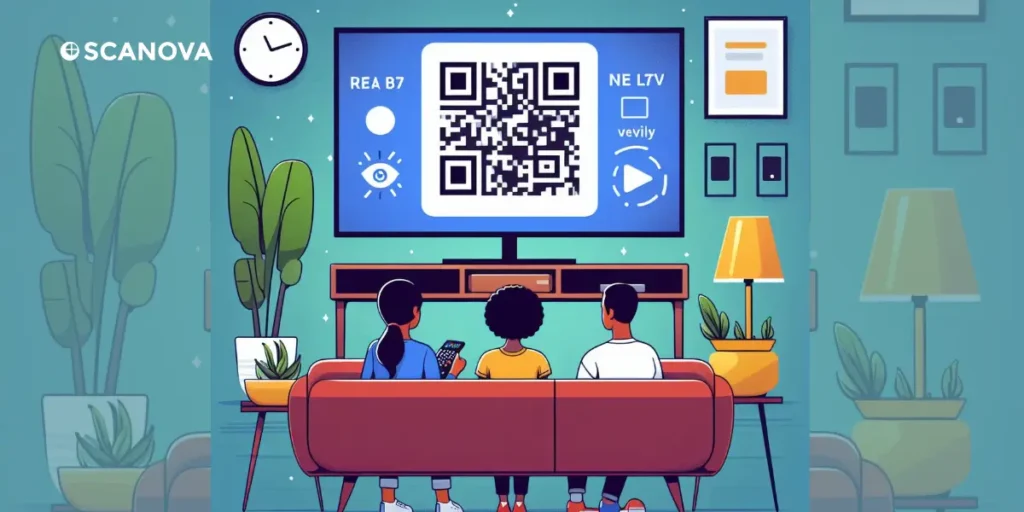
1. Emerging Trends and Innovations
Dynamic QR Codes: Future advancements include dynamic QR Codes that can be updated in real-time to deliver personalized content or adapt to changing campaign objectives.
Dynamic QR Codes enable greater flexibility and customization, allowing brands to deliver targeted messages and promotions based on user preferences and behavior.
Interactive Experiences: QR Codes on TV commercials may evolve to offer more interactive and immersive experiences, such as augmented reality (AR) overlays, gamification elements, or interactive storytelling.
Many big brands like Coca-Cola, Mahindra, Puma, etc have already started using QR Codes on TV commercials to provide immersive AR experiences.
Over 70% of people use QR Codes when viewing TV ads or programming, indicating an increasing trend in interactive advertising (Forbes 2023).
By integrating QR Codes with emerging technologies, brands can create memorable experiences that captivate audiences and drive deeper engagement with TV advertising.
2. Potential applications beyond commercials
QR Codes can be integrated into product packaging to provide consumers with product information, usage instructions, or access to digital content.
Brands can leverage QR Codes to enhance the post-purchase experience and foster ongoing engagement with their products.
Many brands like Nestle and McDonald’s already use these QRs to inform users about the products and build trust.
QR Codes can also be used in event marketing to streamline attendee registration, provide event schedules or maps, and facilitate networking opportunities.
Using QR Codes, event organizers can enhance the attendee experience and collect valuable data on attendee engagement and behavior.
3. Integration with Augmented Reality (AR) and other technologies
I. AR Integration
QR Codes can be combined with AR technology to create immersive and interactive experiences that blend the physical and digital worlds.
AR-enabled QR Codes can unlock virtual overlays, 3D models, or interactive animations, enriching TV commercials with engaging content and storytelling elements.
II. IoT Integration
QR Codes can be integrated with Internet of Things (IoT) devices to enable seamless connectivity and interaction between physical products and digital platforms.
By scanning QR Codes, users can access product-specific information, control smart devices, or participate in IoT-enabled experiences, enhancing the utility and value of QR Codes on TV commercials.
H. FAQs: QR Codes on TV commercials

1. What are QR Codes, and how do they work?
QR Codes, short for Quick Response codes, are two-dimensional barcodes that can store various types of information, such as website URLs, text, or contact details.
They work by encoding data into a pattern of black squares arranged on a white background.
Users can scan QR Codes using a smartphone camera and a QR Code scanning app, which decodes the information and directs users to the linked content or action.
2. How are QR Codes integrated into TV commercials?
QR Codes are typically integrated into TV commercials by displaying them on-screen at strategic moments during the advertisement.
Viewers can scan the QR Codes using smartphones to access additional content, special offers, or interactive experiences related to the advertised product or service.
3. What are the benefits of using QR Codes on TV commercials?
Using QR Codes in TV commercials offers several benefits, including:
- Providing instant access to additional information or exclusive content.
- Facilitating interactive engagement with viewers.
- Tracking and analyzing consumer behavior to optimize marketing strategies.
- Bridging the gap between offline and online marketing channels.
4. Are there any challenges associated with QR Codes on TV commercials?
Although QR Codes are easy to use there might be some challenges:
- Ensuring consumer adoption and familiarity with QR Codes.
- Addressing technical issues and compatibility with different devices.
- Managing privacy and security concerns related to QR Code scanning.
- Designing effective QR Code placement and optimizing user experience.
5. How can brands measure the effectiveness of QR Codes on TV commercials?
Brands can measure the effectiveness of QR Codes on TV commercials by tracking metrics such as:
- The number of QR Code scans.
- Location, time, and frequency of scans.
- Conversion rates and engagement with linked content.
- Changes in brand awareness, sentiment, or purchase intent.
6. What are some best practices for integrating QR Codes into TV commercials?
While QR Codes offer exciting possibilities, there are some things to consider for optimal impact:
- Clear Call to Action: Tell viewers exactly what they’ll get by scanning the code. Do they get a discount? Early access to a new product? A fun behind-the-scenes clip?
- Simple and Scannable: Make sure the code is large enough and clear on screen, even from a distance.
- Dynamic Content: Consider using dynamic QR Codes that can be updated to reflect different campaigns or promotions.
7. Can QR Codes be used for more than just accessing websites in TV commercials?
Yes, QR Codes can be used for various purposes beyond accessing websites, including:
- Providing product information or tutorials.
- Offering discounts, coupons, or promotions.
- Enabling direct purchases or bookings.
- Collecting feedback or conducting surveys.
- Connecting viewers with social media channels or interactive experiences.
8. Are QR Codes effective on streaming and OTT platforms?
Yes. Studies show that up to 60% of 18–34-year-olds have already scanned a QR Code from a TV screen, including streaming services. OTT and connected TV campaigns are ideal for QR Codes because viewers are already using second screens while watching (Source: PR Newswire).
9. Can a QR Code replace a URL in TV ads?
Yes. In fact, QR Codes work better than displaying a long URL. They save viewers from typing and reduce friction. For best results, always add a short CTA that tells viewers what they will get after scanning.
Conclusion
QR Codes are a sign of the evolving advertising landscape. Adding interactivity to commercials transforms them from mere entertainment to a tool for enhancing brand engagement.
So, the next time you see a blocky square on your TV, grab your phone and get ready to be a part of the action.
